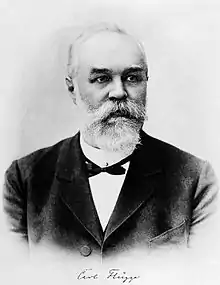Carl Flügge
Carl Georg Friedrich Wilhelm Flügge (12 September 1847 – 10 December 1923) was a German bacteriologist and hygienist. His finding that pathogens were present in expiratory droplets large enough to settle around an individual, the eponymous Flügge droplets, laid ground for the concept of droplet transmission as a route for the spread of respiratory infectious diseases.

Early life and education
Carl Flügge was a native of Hanover. He studied medicine in Göttingen, Bonn, Leipzig and Munich, and in 1878 was a lecturer of hygiene in Berlin.
Career
In 1881 Flügge became the first chair of hygiene at the University of Göttingen, and afterwards a professor at the Universities of Breslau and Berlin, where he succeeded Max Rubner at the Department of Hygiene.
Flügge was a colleague of microbiologist Robert Koch, with whom he co-edited the journal Zeitschrift für Hygiene und Infektionskrankheiten.[1] Two of his better-known assistants at Breslau were Wolfgang Weichardt (1875–1943) and Walther Kruse (1864–1943).
Legacy
Flügge is known for advocating hygiene as an independent medical discipline, and is remembered for performing extensive research involving the transmission of infectious diseases such as malaria, tuberculosis and cholera. In the 1890s, he demonstrated that even during "quiet speech", minute droplets, the Flügge droplets are sprayed into the air. This laid ground to the concept of droplet transmission, still in use in the 21 st century.[2] The finding was instrumental in Jan Mikulicz-Radecki's advocacy of surgical gauze masks in 1897.
Publications
Among his publications are two important books on hygiene:
- Lehrbuch der hygienischen Untersuchungsmethoden; (“Textbook of hygienic investigation methods”).
- Grundriss der Hygiene; (“Outline of hygiene”, new edition 1902).
Other works include:
- Beiträge zur Hygiene; (“Contributions to hygiene”, 1872).
- Die Mikroorganismen: mit besonderer Berücksichtigung der Ätiologie der Infektionskrankheiten; (“Microorganisms”, third edition 1896).
Articles include:
- Die Verbreitung der Phthise durch staubförmiges Sputum und durch beim Husten verspritzte Tröpfchen. Zeitschrift für Hygiene und Infektionskrankheiten volume 30, pages 107–124 (1899)
References
- Mazumdar, Pauline M. H. (18 July 2002). Species and Specificity: An Interpretation of the History of Immunology. Cambridge University Press. pp. 83–. ISBN 978-0-521-52523-7.
- Bourouiba, Lydia (26 March 2020). "Turbulent Gas Clouds and Respiratory Pathogen Emissions: Potential Implications for Reducing Transmission of COVID-19". JAMA. doi:10.1001/jama.2020.4756. ISSN 0098-7484.
Bibliography
| Wikimedia Commons has media related to Karl Flügge. |
- Lehrbuch der hygienischen Untersuchungsmethoden
- The Gospel of Germs: Men, Women, and the Microbe in American Life
- Charles M. Poser, G. W. Bruyn (1999). An illustrated history of malaria. Informa Health Care. p. 39. ISBN 1-85070-068-0.
- Rines, George Edwin, ed. (1920). . Encyclopedia Americana.